Dean Lomax
Honorary Visity Scientist: School of Earth, Atmospheric and Environmental Sciences, The University of Manchester
William Wahl
2003-2006 Ft. Hays State University, Hays, KS M.S. in Vertebrate Paleontology 2006
1994-1997 University of Wyoming Casper College, Casper, WY B.S Natural Sciences, 1997.
1986-1990 University of New Orleans, New Orleans, LA major in geology; no degree
Dean R. Lomax and Christopher A. Racay
A mortichnial trackway is one which ends in the track maker. This means that for one reason or another, the track maker died in its tracks. In the case of M. walchi, the crab likely died of asphyxiation in the low oxygen, hyper-saline enviroment of the lagoon it fell into. At the beginning of this 9.7m (32ft) trackway, there are impressions of what appears to be the crab's back. The authors think it was tossed into the lagoon by a storm, righted itself, and tried to escape the harsh environment until it succumbed. While it is sad for the crab, this trackway helps paleontologists illuminate the behavior of the trackmaker and others that leave similar tracks.
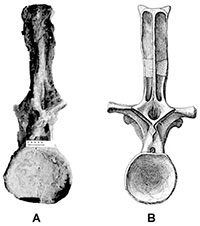
David M. Lovelace, Scott A. Hartman, and William Wahl
The figure to the left compares the 3rd dorsal vertebrae of Supersaurus vivianae(A) with the same bone of Apatosaurus(B). Only 2 specimens of Supersuarus vivianae have ever been found. When the first specimen was found in a jumble of bones in the Dry Mesa Quarry in 1985, the scientist who studies them split the fossilised material into 3 species. Later, it was decided that the 3 species were just Supersaurus. Because the Douglas Quarry, the other instance of Supersaurus, was one individual, scientists were able to show that the bones assigned to Supersaurus earlier were correctly assigned.
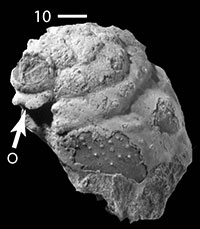
Rodney M. Feldman, Carrie E. Schweitzer, and William R. Wahl
These minute crabs (scale bar=1mm), found in northwest USA, link previously described species from the Jurassic and Cretaceous because of their uniquely large eyes (marked by O). They document a change in evolution known as exadaptation. The sediments around the crabs indicate that they were living in reefs, but the large eyes lead the authors to say that the crab was likely nocturnal. The Cretaceous relatives of these crabs live in the deep ocean, an environment that was already open to them because of their large eye
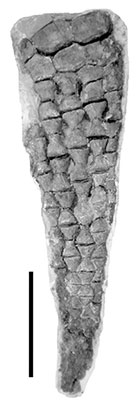
William R. Wahl, Judy Massare, and Mike Ross
In 1895, 2 limbs, much of the limb girdle, and some vertebra where recovered by Wilbur Knight. they were found in the Red Water Shale member of the Upper Sundace, making them about 160 million years old. When excavators returned to the site in 2008, they found a nearly whole and articulated forelimb of the same animal. Using the forelimb as a guide, they reassembled the hind limb ing the UW collection. This site also has the distinction of being an archaeological site as some artifacts from Wilbur Knight as his crew were recovered.
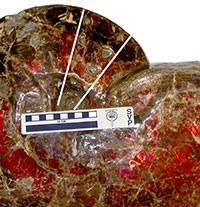
William R. Wahl
Using CT scanning, it was determined that the holes in the shell of our ammonite specimen were caused by punctures rather than collapsed areas weakened by limpet rasping.The holes occur in matching V shapes on either side of the ammonite and do not resemble holes created by limpets. Not only is this a beautiful ammonite, it is also a fasinating ichnological specimen.

Dean R. Lomax
A well preserved ichthyosaur specimen from the paleontology collection of Doncaster Museum and Art Gallery,
England is described with a focus on the gastric material scattered around the ribs and throughout the matrix. The
gastric material comprises coleoid cephalopod hooklets. The ichthyosaur has been dated from the Pliensbachian Stage
of the Lower Lias rocks of the Charmouth coastline, Dorset, England. The specimen is identified as Ichthyosaurus sp.
and thus extends the geologic range of the genus into the Pliensbachian. The specimen comprises a complete skull,
articulated vertebrae, ribs and a fully articulated forefin. The specimen may also contain coprolites preserved within
the posterior end of the matrix.
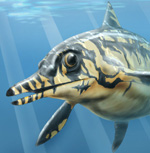
William R. Wahl
In July 1998, a partially articulated anterior skeleton of Opthalmosaurus was collected from the Redwater Shale Member of the Sundance Formation, Natrona County, WY. The skull was disconnected from the vertebral column at the atlas-axis and rested upside down at a nearly 90◦ angle to the bedding. The skull and associated vertebrae are partially encased in at least two generations of concretion. Borings on the partially articulated pectoral girdle, ribs and vertebrae suggest that the specimen was exposed on the sea floor. No such evidence, however, was found on the middle and distal portions of the skull, further suggesting that it was partially driven into the sediment by the impact of the carcass.
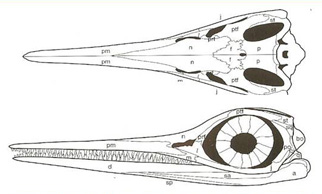
William R. Wahl
Salt glands allow marine reptiles to drink seawater and have been noted on plesiosaurs and marine crocodiles. UW24816 is a large and almost complete opthalmosaur skull preserved in three dimensions, but fractured into a series of cross-sectional views. A section anterio-dorsal to the orbits revealed paired structures preserved within the sediment of the skull which extend to the external nares. The described pockets are sub-triangular, bordered by the prefrontal/lachrymal contact anteriorly and by the nasal bones dorsally and suggest preserved paired salt glands.
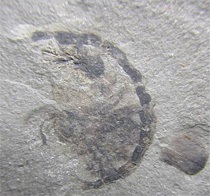
William R. Wahl
Siphuncle structures and internal features of Neogastroplites americanus from the Mowry Formation (Lower Cretaceous, Albian) are recorded for the first time. The extraordinary preservation of an organic structures as a carbon film allows observation of tube-like structures in these ammonites.

William R. Wahl
Remains of a shark specimen were found in the gastric contents of a small-bodied plesiosaur. The fossil material was identified as a member of the Hybodontiformes based on the teeth and dorsal spine denticles. The specimen is the first hybodont shark to be identified from the Upper Sundance Formation of Wyoming. Hybodont shark material previously described was limited to the Lower Sundance and not associated with marine reptile remains. The hybodont specimen described here may indicate a different type of predation on the marine vertebrate and invertebrate environment of the Sundance Formation biota.

William R. Wahl, Mike Ross, and Judy A. Massare
We report the rediscovery of Wilbur Knight’s 1895 excavation site of the large Jurassic (Oxfordian) pliosaur Megalneusaurus rex from the Sundance Formation. The type specimen (UW4602) is housed at the University of Wyoming and is the only known pliosaur from the Sundance Formation. Recent examination of the excavation site has uncovered new fossil material including possible gastric contents. We can now verify that Megalneusaurus rex was collected from the upper Redwater Shale member of the Sundance Formation, about 10 m below the Windy Hill sandstone of the Morrison Formation. It appears that M. rex frequented the shallower portions of the Sundance Sea during the last regressive phase. The discovery of the site is significant in establishing the stratigraphic context of this largest member of the Sundance marine reptile fauna.
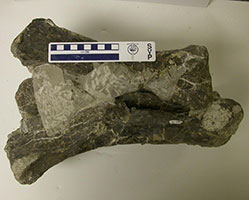
William R. Wahl
In the course of preparation of dinosaur material skeletal elements have been noted with bone material mixed into matrix in the bone/matrix contact. Material from the interior of large limb bones of WDC-BS quarry appears to have been “squirted” out of the bone matrix contact. The potential “rotting” in a sub-aqueous organic-rich alkaline paleoenvironment has been suggested to describe both microbial and geochemical processes that occurred in the destruction of both the cancellous and surficial bone.
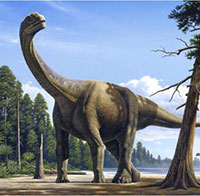
Tristan C. Birkemeier and William R. Wahl
The Beside Sauropod (BS) Quarry is a disarticulated bonebed of Camarasaurus lentus from Thermopolis, Wyoming, that contains numerous pathological bones. The most pertinent of the pathologies is osteoarthritis, a condition rarely seen in the fossil record. Other pathologies include ossifications in the vertebrae, sacrum and scapulae; thickening of the vertebral centrum margins; two fused dorsal vertebrae; two fused caudal vertebrae; distal caudal vertebrae fused at the neural arch; costovertebral (rib to vertebrae) fusions; and an unusual dual-shafted dorsal rib.
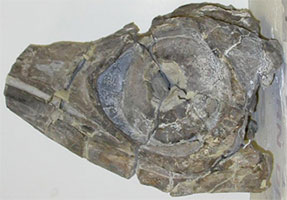
Judy A. Massare and William R. Wahl
A specimen of Ophthalmosaurus natans(UW 24216) was collected from the upper Redwater Shale member of the Sundance Formation in northern Natrona County, WY. It includes the skull, the anterior portion of the vertebral column, most of the shoulder girdle, and numerous ribs. The skull is approximately 1 m long, but the distal end of the ramus is missing.
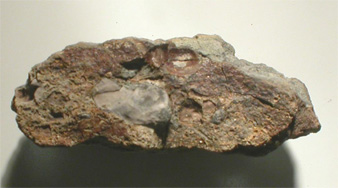
William R. Wahl
A unique micro-facies consisting of massed vertebrate material in a dense black concreted matrix may represent a disarticulated coprolite layer. The fossil material occurs in a lens type concretion and is represented by teeth and vertebra with a size range of .5mm or less and occurs 42m below the Neogastropiltes haasiammonite biozone. Though the oyster Inoceramus is ubiquitous throughout the formation, no shell material was noted within the tooth dominated matrix.
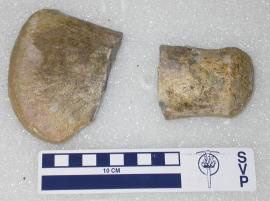
William R. Wahl
The predominance of juvenile forms from one taxon is unique in faunal studies. The large amount of juvenile cryptocleidoid plesiosaurs from the Redwater Shale Member of the Sundance Formation may identify such a paleocommunity Seven out of the ten specimens found in one field collection can be identified as juveniles.
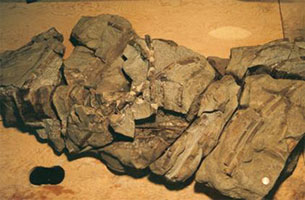
William R. Wahl
Decapod material is rare from Jurassic rocks in North America. Recent fieldwork has produced new material found associated with an articulated ichthyosaur (UW 24602) preserved in a calcareous concretion collected from the Redwater Shale member of the Sundance Formation. The decapod material appears to be fragmentary bits of cuticle found mixed into burrow fill within the recesses of the ichthyosaur skull and adjacent to vertebrae.

William R. Wahl
Preserved bites are a rare demonstration of predator and prey interaction and give a useful view of paleoecology. Non-invasive tests were utilized in an investigation of bites in a specimen of Placenticeras meeki at the Wyoming Dinosaur Center, Thermopolis, Wyoming. (WDC-Bps-002). This
investigation led to a reevaluatition of the limpet home marks vs. mosasaur predation bite hypothesis.
Powered by Firespring.org